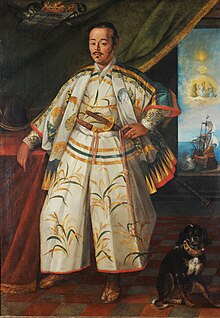Hasekura Tsunenaga 支倉常長 | |
|---|---|
 Hasekura portrayed during his mission in Rome by Archita Ricci, 1615 | |
| Born | Yamaguchi Yoichi (山口与市) c. 1571 Sendai Domain, Northeastern Japan |
| Died | 7 August 1622 (aged 50–51) Ōsato, Miyagi, Japan |
| Other names | Don Felipe Francisco Hasekura (Christianized name) |
| Occupation | Diplomat |
| Children | Hasekura Yoritomo (d. 1640), Hasekura Yorimichi (?-?) |
| Family | Hasekura Tsunenobu (d. c. 1685) |

Hasekura Rokuemon Tsunenaga (支倉 六右衛門 常長, 1571–1622) was a kirishitan Japanese samurai and retainer of Date Masamune, the daimyō of Sendai. He was of Japanese imperial descent with ancestral ties to Emperor Kanmu. Other names include Philip Francis Faxicura, Felipe Francisco Faxicura, and Philippus Franciscus Faxecura Rocuyemon in period European sources, as he took a baptismal name upon converting to Catholicism.
In the years 1613 through 1620, Hasekura headed the Keichō Embassy (慶長使節), a diplomatic mission to Pope Paul V. He visited New Spain and various other ports-of-call in Europe on the way. On the return trip, Hasekura and his companions re-traced their route across New Spain in 1619, sailing from Acapulco for Manila, and then sailing north to Japan in 1620.
Although Hasekura's embassy was cordially received in Spain and Rome, it happened at a time when Japan was moving toward the suppression of Christianity. European monarchs refused the trade agreements Hasekura had been seeking. He returned to Japan in 1620 and died of illness a year later, his embassy seemingly ending with few results in an increasingly isolationist Japan.
Japan's next embassy to Europe would not occur until more than 200 years later, following two centuries of isolation, with the "First Japanese Embassy to Europe" in 1862.